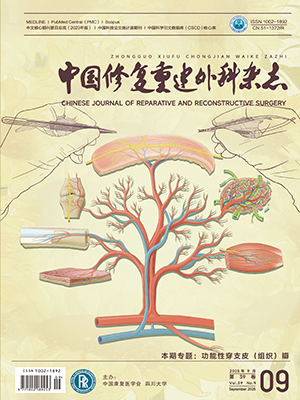| 1. |
Sagher O, Parmar HA. Traumatic brain injury. J Neurosurg, 2012, 116(5): 1060-1061.
|
| 2. |
Schouten JW, Fulp CT, Royo NC, et al. A review and rationale for the use of cellular transplantation as a therapeutic strategy for traumatic brain injury. J Neurotrauma, 2004, 21(11): 1501-1538.
|
| 3. |
Rapoport MJ. Depression following traumatic brain injury: epidemiology, risk factors and management. CNS Drugs, 2012, 26(2): 111-121.
|
| 4. |
Gao X, Chen J. Moderate traumatic brain injury promotes neural precursor proliferation without increasing neurogenesis in the adult hippocampus. Exp Neurol, 2013, 239: 38-48.
|
| 5. |
杨林, 赵洪洋, 赵甲山, 等. 体外标记神经干细胞脑内移植治疗大鼠创伤性脑损伤. 中华实验外科杂志, 2006, 23(2): 209-211.
|
| 6. |
Chopp M, Li Y. Transplantation of bone marrow stromal cells for treatment of central nervous system diseases. Adv Exp Med Biol, 2006, 585: 49-64.
|
| 7. |
许朝进. 神经干细胞与BMSCs移植治疗脊髓损伤的研究进展. 中国修复重建外科杂志, 2012, 26(2): 186-189.
|
| 8. |
Guo S, Zhen Y, Wang A. Transplantation of bone mesenchymal stem cells promotes angiogenesis and improves neurological function after traumatic brain injury in mouse. Neuropsychiatr Dis Treat, 2017, 13: 2757-2765.
|
| 9. |
Hsieh WC, Chang CP, Lin SM. Morphology and characterization of 3D micro-porous structured chitosan scaffolds for tissue engineering. Colloids Surf B Biointerfaces, 2007, 57(2): 250-255.
|
| 10. |
Ji C, Khademhosseini A, Dehghani F. Enhancing cell penetration and proliferation in chitosan hydrogels for tissue engineering applications. Biomaterials, 2011, 32(36): 9719-9729.
|
| 11. |
Ran J, Xie L, Sun G, et al. A facile method for the preparation of chitosan-based scaffolds with anisotropic pores for tissue engineering applications. Carbohydr Polym, 2016, 152: 615-623.
|
| 12. |
汪大彬, 文益民, 蓝旭, 等. 壳聚糖-藻酸盐支架复合BMSCs修复急性脊髓损伤的实验研究. 中国修复重建外科杂志, 2010, 24(2): 190-196.
|
| 13. |
衣昕. 壳聚糖作载体的神经干细胞移植修复脑损伤研究. 江苏南通: 南通大学, 2007.
|
| 14. |
Hsu YY, Gresser JD, Trantolo DJ, et al. Effect of polemer foam morphology and density on kinetics of in vitro controlled release of isoniazid from compressed foam matrices. J Biomed Master Res, 1997, 35(1): 107-116.
|
| 15. |
Andelic N. The epidemiology of traumatic brain injury. Lancet Neurol, 2013, 12(1): 28-29.
|
| 16. |
Kernie SG, Erwin TM, Parada LF. Brain remodeling due to neuronal and astrocytic proliferation after controlled cortical injury in mice. J Neurosci Res, 2001, 66(3): 317-326.
|
| 17. |
Cox CS Jr, Hetz RA, Liao GP, et al. Treatment of severe adult traumatic brain injury using bone marrow mononuclear cells. Stem Cells, 2017, 35(4): 1065-1079.
|
| 18. |
郑蕊, 廖承德, 丁莹莹. 体外诱导骨髓间充质干细胞向神经细胞分化的研究进展. 现代肿瘤医学, 2015, 23(7): 1067-1069.
|
| 19. |
Blennow K, Hardy J, Zetterberg H. The neuropathology and neurobiology of traumatic brain injury. Neuron, 2012, 76(5): 886-899.
|
| 20. |
Pierce JE, Smith DH, Trojanowski JQ, et al. Enduring cognitive, neurobehavioral and histopathological changes persist for up to one year following severe experimental brain injury in rats. Neuroscience, 1998, 87(2): 359-369.
|
| 21. |
Lam PK, Lo AW, Wang KK, et al. Transplantation of mesenchymal stem cells to the brain by topical application in an experimental traumatic brain injury model. J Clin Neurosci, 2013, 20(2): 306-309.
|
| 22. |
胡炜, 刘俊, 姜健, 等. 骨髓间质干细胞对大鼠脑损伤后血管再生的影响. 中南大学学报 (医学版), 2016, (5): 489-494.
|
| 23. |
Chang CP, Chio CC, Cheong CU, et al. Hypoxic preconditioning enhances the therapeutic potential of the secretome from cultured human mesenchymal stem cells in experimental traumatic brain injury. Clin Sci (Lond), 2013, 124(3): 165-176.
|
| 24. |
Walker PA, Shah SK, Jimenez F, et al. Bone marrow-derived stromal cell therapy for traumatic brain injury is neuroprotective via stimulation of non-neurologic organ systems. Surgery, 2012, 152(5): 790-793.
|




